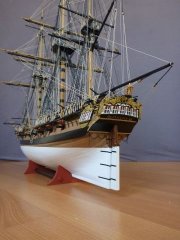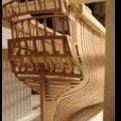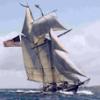MORE HANDBOOKS ARE ON THEIR WAY! We will let you know when they get here.
×
-
Posts
7,403 -
Joined
-
Last visited
Reputation Activity
-
 Mirabell61 got a reaction from kier in HMS Pegasus 1776 by Mirabell61 - FINISHED - scale 1:64 - 16-gun sloop
Mirabell61 got a reaction from kier in HMS Pegasus 1776 by Mirabell61 - FINISHED - scale 1:64 - 16-gun sloop
Galley stove , continued....
painted, cooking side
spit roast side
brass parts fitted
stove heaved into ist place
view through portside gunport
Oh, oh, there is not going to be much place for the cook....
Build log part 32 to follow...
Nils
-
 Mirabell61 got a reaction from Jeronimo in HMS Pegasus 1776 by Mirabell61 - FINISHED - scale 1:64 - 16-gun sloop
Mirabell61 got a reaction from Jeronimo in HMS Pegasus 1776 by Mirabell61 - FINISHED - scale 1:64 - 16-gun sloop
Build log part 30
next will be the galley stove I did yesterday, but I still Need to fit the spit roast with its Elevation devices
this is the stove raw material, 20mm square bar
cutting into shape, and an Adapter for the chimney pipe
cutting out the fireing and baking space
drip pan for the spit roast side, Support logs and baseplate
further Fitting out....
riveting the corners
to be continued....
Nils
-
 Mirabell61 got a reaction from kier in HMS Pegasus 1776 by Mirabell61 - FINISHED - scale 1:64 - 16-gun sloop
Mirabell61 got a reaction from kier in HMS Pegasus 1776 by Mirabell61 - FINISHED - scale 1:64 - 16-gun sloop
Galley stove continued.... and ending
spit roast supports and crank handle
here for Crackers and B.E.
Making of drinking water for the Crew from distilled seawater
condensate collector Barrel with drain tap
also hinges to the stove doors and to the chimney flap
The place between stove side and Barrel is for the cheeks of the riding bitt supports
all at ist place on board for fit check
Nils
-
 Mirabell61 got a reaction from themadchemist in HMS Pegasus 1776 by Mirabell61 - FINISHED - scale 1:64 - 16-gun sloop
Mirabell61 got a reaction from themadchemist in HMS Pegasus 1776 by Mirabell61 - FINISHED - scale 1:64 - 16-gun sloop
Oh lovely reading Keith,
and very interesting also, many thanks to you..
Nils
-
 Mirabell61 reacted to themadchemist in HMS Pegasus 1776 by Mirabell61 - FINISHED - scale 1:64 - 16-gun sloop
Mirabell61 reacted to themadchemist in HMS Pegasus 1776 by Mirabell61 - FINISHED - scale 1:64 - 16-gun sloop
One of the issues, as Popeye mentioned, is micro organisms.
In this day of chlorinated water, it can be kept for long periods without fear. When distilled it removes the chlorine and then allows air borne microbes to seed the water and make it grow microbes. Distilled water has a shorter shelf-life then modern water...but back then I'm sure it was much preferred to what would be called potable water (anything considered drinkable). Important issues like this are interesting to think about, as being at sea in those days could be as bad a situation as Apollo 13's being stuck out in space.
If I remember correctly back when I read Bligh's account of the mutiny after voyage, water was a key. The first part of the trip it rained and ruined part of the food but allowed the collection of water, but later they needed but could not go to shore to search for water due to the fear of natives. One of their first stops ended in dead members.
I'd say for the sailor of a few centuries back, water was the first concern, and distillation was a way of making sea water potable.
Distillation can be traced back to the Ancient Greeks so it was a long known process and easily achievable.
I'm just guessing here, but what Michael says makes sense. Grog and rum with even the small alcohol content of grog, was the chlorination of the day. Alcohol killed microbes and helped keep the water safe and healthy... and this wasn't just at sea.
Anyway, enough physic lecture.
a toast,
To Nils distiller, long may her condenser flow nectar, cheers
Oh by the way Nils, as your a German here's something to encourage national pride...
In 1500, German alchemist Hieronymus Braunschweig published Liber de arte destillandi (The Book of the Art of Distillation) the first book solely dedicated to the subject of distillation. So even though the process dates back at least to Alexander the Great, German put it on paper first .
-
 Mirabell61 got a reaction from themadchemist in HMS Pegasus 1776 by Mirabell61 - FINISHED - scale 1:64 - 16-gun sloop
Mirabell61 got a reaction from themadchemist in HMS Pegasus 1776 by Mirabell61 - FINISHED - scale 1:64 - 16-gun sloop
Thank you Keith,
I`ve learnt quite a lot in the last days for anchor cable rigging, for condenser devices, distilled water, etc all from fellow members, this is great Input...
Nils
-
 Mirabell61 got a reaction from Beef Wellington in HMS Snake by Beef Wellington - FINISHED - Caldercraft - Scale 1: 64 - First wooden ship build
Mirabell61 got a reaction from Beef Wellington in HMS Snake by Beef Wellington - FINISHED - Caldercraft - Scale 1: 64 - First wooden ship build
your rigging the blocks Looks great Jason,
Nils
-
 Mirabell61 got a reaction from Mfelinger in HMS Pegasus 1776 by Mirabell61 - FINISHED - scale 1:64 - 16-gun sloop
Mirabell61 got a reaction from Mfelinger in HMS Pegasus 1776 by Mirabell61 - FINISHED - scale 1:64 - 16-gun sloop
Galley stove continued.... and ending
spit roast supports and crank handle
here for Crackers and B.E.
Making of drinking water for the Crew from distilled seawater
condensate collector Barrel with drain tap
also hinges to the stove doors and to the chimney flap
The place between stove side and Barrel is for the cheeks of the riding bitt supports
all at ist place on board for fit check
Nils
-
 Mirabell61 reacted to dafi in Channels, deadeyes and shrouds
Mirabell61 reacted to dafi in Channels, deadeyes and shrouds
During my build on the Victory there is always some need to talk or to explore deeper, and one realizes, that many details are not properly defined and are much more judged merely by kind of mental cinema than researched facts.
It started with a discussion in our german forum about the orientation of the free end of the shroud: Always left, always right or different depending on the side of the ship?!?
Here we had a research in the common literature and the results were quite similar with:
- for the cable-laid shrouds - Starboard side the free end pointing foreward, larboard aft - for plain- or hawser-laid shrouds - Starboard side the free end pointing aft, larboard foreward Background technically wise is that the rope always tends to curl in one direction and the free end should be crossing on the inner side, this leads automatically to the above mentioned orientations. If one simply flips the deadeye the free end would end up outside. And please do not refer to the shrouds star- and larboard having different twists: Forget it, that is a marine myth created by Mr. Monfeld and is already revoked by himself - not without some gnashing of teeth on his side ;-) Here some literature with the above mentioned orientation in green
Schrage Rundhölzer ... page 81 Fig. 224/226 "Von außen gesehen wurden die Kabelweis geschlagenen Wanttaue von rechts nach links um die Jungfer gelegt, so dass an jeder Schiffsseite der Tamp hinter dem Want an der rechten Seite des Wanttaus zu liegen kam. Dort wo sich beide Parten über der Jungfer kreuzen, wurde die erste Bindselung angelegt und der rechts liegende Tamp mit zwei Plattbindselungen am Wanttau befestigt." Marquardt, Schoner in Nord und Süd page 128 Fig 41 "Bei kabelgeschlagenen war das Ende oberhalb der Juffer links beigebunden (an Backbordseite nach hinten weisend), während trossengeschlagene entgegengesetzt beigebunden wurden." Lee Masting and Rigging ... Drawing pages 40 and 42 as mentioned above (only one side shown) Petersson Rigging period Fore-and-Aft Craft Drawing page 16 as mentioned above (only one side shown) Petersson Rigging period shipmodels Drawing page 2 bis 4 as mentioned above (only one side shown) Harland Seamanship Drawing page 22 as mentioned above (only one side shown) Darcy Lever Sheet Anchor "The Lanyard has a ... Knot ... cast on the end ; which is placed the reversed way to what the end of the Shroud is: thus in Cable laid Shrouds, the ends on the larbord side lies aft; on the starboard side forewards; ..." Drawing page 24 as mentioned above (only one side shown) Boudriot shows the same orientation for the frensh (thanks to pollux for the information) The Victory in Portsmouth was shown the same way (at least until the actual rerigging) Nares, Brady und Biddlecombe only describe Cutter Stay fashion The only one telling the other direction is Marquardt in Eighteenth Century Rigs and Rigging, which contradicts his own Book Schooner Nord und Süd On this occasion I found some other useful information: - Max. distance of the big deadeyes twice diameter
- Tackle about half the diameter of the shroud
- Shroud not too tight around the deadeye
- free end of the tackle passes through the gap of deadeye and shroud
- free end not too long But it left me with some further questions: - The top-mast shrouds were plain laid or cable laid (cablets)? Plain laid would mean that the ends would be pointing the other way than on the lower shrouds. - The same for backstays? - The distance of twice diameter of the deadeye looks good on the lower shrouds lanyards. Is this applicable too for the topmast shrouds? There the distance usually looks much longer in comparison?
- When was the batten on top of shrouds introduced to maintain their orientation? Marquardt only makes a small remark in the picture section telling "about 1800".
- Was this also introduced for the topmast shrouds?
popeye2sea already replied one hint:
Steels, Art of Rigging simply states "Dead-eyes are turned into the lower end of the top mast shrouds, as the lower ones are into to lower shrouds.
(Thank you mate!!!)
Cheers, Daniel -
 Mirabell61 reacted to themadchemist in HMS Pegasus 1776 by Mirabell61 - FINISHED - scale 1:64 - 16-gun sloop
Mirabell61 reacted to themadchemist in HMS Pegasus 1776 by Mirabell61 - FINISHED - scale 1:64 - 16-gun sloop
I like the distiller. To answer the question, distilled water would be salt free and mineral free, for that matter.
It would be a not very efficient way to make water, but in emergency its would do. Basically due to what Jason mentioned of the fuel required to boil the water, but if the stove is going anyway the excess heat might as well be used to get as much out of the fuel as possible and distilling water or spirits would be a good use for this.
Kind of like cooking a big pan of soup in the winter to help warm up the house, which is efficient unlike cooking it in the summer and having to use A/C to remove the heat from the house. Sailors were masters of efficiency as it tended to help extend the length of life in an environment that could be hazardous and unpredictable.
Anyway, nice stove Nils, I like the rivets. Its added a nice touch.
-
 Mirabell61 got a reaction from avsjerome2003 in HMS Pegasus 1776 by Mirabell61 - FINISHED - scale 1:64 - 16-gun sloop
Mirabell61 got a reaction from avsjerome2003 in HMS Pegasus 1776 by Mirabell61 - FINISHED - scale 1:64 - 16-gun sloop
Galley stove continued.... and ending
spit roast supports and crank handle
here for Crackers and B.E.
Making of drinking water for the Crew from distilled seawater
condensate collector Barrel with drain tap
also hinges to the stove doors and to the chimney flap
The place between stove side and Barrel is for the cheeks of the riding bitt supports
all at ist place on board for fit check
Nils
-
 Mirabell61 got a reaction from Elmer Cornish in HMS Pegasus 1776 by Mirabell61 - FINISHED - scale 1:64 - 16-gun sloop
Mirabell61 got a reaction from Elmer Cornish in HMS Pegasus 1776 by Mirabell61 - FINISHED - scale 1:64 - 16-gun sloop
Galley stove , continued....
painted, cooking side
spit roast side
brass parts fitted
stove heaved into ist place
view through portside gunport
Oh, oh, there is not going to be much place for the cook....
Build log part 32 to follow...
Nils
-
 Mirabell61 got a reaction from themadchemist in HMS Pegasus 1776 by Mirabell61 - FINISHED - scale 1:64 - 16-gun sloop
Mirabell61 got a reaction from themadchemist in HMS Pegasus 1776 by Mirabell61 - FINISHED - scale 1:64 - 16-gun sloop
Build log part 30
next will be the galley stove I did yesterday, but I still Need to fit the spit roast with its Elevation devices
this is the stove raw material, 20mm square bar
cutting into shape, and an Adapter for the chimney pipe
cutting out the fireing and baking space
drip pan for the spit roast side, Support logs and baseplate
further Fitting out....
riveting the corners
to be continued....
Nils
-
 Mirabell61 got a reaction from Elmer Cornish in HMS Pegasus 1776 by Mirabell61 - FINISHED - scale 1:64 - 16-gun sloop
Mirabell61 got a reaction from Elmer Cornish in HMS Pegasus 1776 by Mirabell61 - FINISHED - scale 1:64 - 16-gun sloop
Galley stove continued.... and ending
spit roast supports and crank handle
here for Crackers and B.E.
Making of drinking water for the Crew from distilled seawater
condensate collector Barrel with drain tap
also hinges to the stove doors and to the chimney flap
The place between stove side and Barrel is for the cheeks of the riding bitt supports
all at ist place on board for fit check
Nils
-
 Mirabell61 got a reaction from marktiedens in HMS Pegasus 1776 by Mirabell61 - FINISHED - scale 1:64 - 16-gun sloop
Mirabell61 got a reaction from marktiedens in HMS Pegasus 1776 by Mirabell61 - FINISHED - scale 1:64 - 16-gun sloop
Galley stove , continued....
painted, cooking side
spit roast side
brass parts fitted
stove heaved into ist place
view through portside gunport
Oh, oh, there is not going to be much place for the cook....
Build log part 32 to follow...
Nils
-
 Mirabell61 reacted to Beef Wellington in HMS Pegasus 1776 by Mirabell61 - FINISHED - scale 1:64 - 16-gun sloop
Mirabell61 reacted to Beef Wellington in HMS Pegasus 1776 by Mirabell61 - FINISHED - scale 1:64 - 16-gun sloop
I see there is a separate discussion on this. I can't help feeling that this probably wouldn't have been a very effective method for providing drinking water considering the necessary large fuel supply needed to generate the volume of water needed for a crew. Conjecture on my part was that this was used for limited 'specialized purpose's (captain/officers food delicacies, sickbay needs etc) rather than a source for crew as a whole. I'm sure others could comment more authoritatively.
-
 Mirabell61 reacted to popeye the sailor in HMS Pegasus 1776 by Mirabell61 - FINISHED - scale 1:64 - 16-gun sloop
Mirabell61 reacted to popeye the sailor in HMS Pegasus 1776 by Mirabell61 - FINISHED - scale 1:64 - 16-gun sloop
all the vitamins and minerals that a growing sailor would need! might even have a bit of protein too! {protozoa}
-
 Mirabell61 got a reaction from popeye the sailor in HMS Pegasus 1776 by Mirabell61 - FINISHED - scale 1:64 - 16-gun sloop
Mirabell61 got a reaction from popeye the sailor in HMS Pegasus 1776 by Mirabell61 - FINISHED - scale 1:64 - 16-gun sloop
Thank you Popeye,
I wonder if the distilled seawater is realy drinkable as it Comes out of the condenser, or if it still contains a reasonable degree of salt ? Would have liked to taste it
Nils
-
 Mirabell61 reacted to popeye the sailor in HMS Pegasus 1776 by Mirabell61 - FINISHED - scale 1:64 - 16-gun sloop
Mirabell61 reacted to popeye the sailor in HMS Pegasus 1776 by Mirabell61 - FINISHED - scale 1:64 - 16-gun sloop
the stove looks sweet! the drinking water cask really adds to the overall look and function........very nicely done!
-
 Mirabell61 reacted to _SalD_ in Phantom by _SalD_ - FINISHED - 1/8" scale
Mirabell61 reacted to _SalD_ in Phantom by _SalD_ - FINISHED - 1/8" scale
Had a productive weekend. I cut the 'step' in at the top of the hull, laid out and installed the stem, stern post and keel and craved the rudder.
To layout out the location of the 'step' I used my drafting compass. I set the distance between the pivot point of the compass and the lead to 1/8". Then by resting the compass's point on top of the bulwarks and using the bulwarks as a guide I was able to scribe a line completely around the ship's hull 1/8" down. I tried craving the 'step' as described in Chuck's practicum but found it to be too labor intensive. So I gave up the knife and tried my dremel. (have the toys, might as well use them) I used a sanding drum and my old drafting metal erasure shield as a guide so I wouldn't remove any material below the line. As I went I kept checking the width of the 'step' with my dividers. Used an emery board to get the 'step' to its correct width and depth.
Next I laid out the stem as described in the practicum on paper to get the proper angle to glue the 1/8" wood strips to and to form a template I could later use to trace on the wood strips. Once the strips were glued and dried I traced the stem on the strips and cut it out. The keel I cut the little lip at the end and scarfed a joint between the stem and keel. The stern post was fairly easy. After gluing everything in place and letting it dry I used some filler to fill in the gaps.
For the rudder, instead of gluing three pieces of the 1/8" wood strips together as in the practicum, I used the 1/16" x 1/2" stock. I cut two pieces approximately 2" long and glued them together to make one piece 1/8" thick x 1/2" wide. I then printed out a copy of the rudder from the plans to use as a template. Used the dremel to get a rough shape and then used files an the x-acto knife to get the finished shape. Used sandpaper to round the front edge and taper the sides. Finally I drilled the hole in the hull and did a test fit.
Also spend a little time making my own waterline marking jig.
-
 Mirabell61 reacted to _SalD_ in Phantom by _SalD_ - FINISHED - 1/8" scale
Mirabell61 reacted to _SalD_ in Phantom by _SalD_ - FINISHED - 1/8" scale
Day 4: Started carving from station 5 to stern. Actually starting to enjoy this. Need to remember to keep chisel sharpened.
Finished rough craving and sanded hull. Came out better than expected. Have one dent but nothing real noticeable, may try filler to even it out.
-
 Mirabell61 reacted to _SalD_ in Phantom by _SalD_ - FINISHED - 1/8" scale
Mirabell61 reacted to _SalD_ in Phantom by _SalD_ - FINISHED - 1/8" scale
Couple questions
Before starting the copper I need to scribe the waterline along the hull. To do this I wanted to build the Launching Ways that the model is displayed on to get its correct position. Now, if I build the Launching Ways per the directions included in the kit the angle of the Launching Ways will be approximately 3 degrees, which will be the angle that the keel will sit at. However, if I measure the angle of the keel from the plans that also came with the kit, that angle measures 4.5 degrees.
My cad drawing of Launching Ways
Ship profile from plans
Now I assume that the waterline on the ship should be horizontal when you have the ship on the display. Yes? No? Doesn’t matter? If so, do I build the Launching Ways per the kit’s directions and use that angle (3 degrees) to scribe my waterline or do I use the angle from the plans (4.5 degrees) and build the Launching Ways to that angle?
I’m leaning towards using the angle from the plans (4.5 degrees) and reworking the Launching Ways, unless that’s totally wrong.
Second question. I was planning ahead and I've noticed that the angles of the two masts are not quite the same. I don’t know if I’m being too precise here or are the two masts just parallel to each other?
Thanks
-
 Mirabell61 reacted to _SalD_ in Phantom by _SalD_ - FINISHED - 1/8" scale
Mirabell61 reacted to _SalD_ in Phantom by _SalD_ - FINISHED - 1/8" scale
Started working on the launching ways. Cut all the pieces and stained them. Made up a little jig to set the cross timbers.
Also painted the hull and marked the waterline. Almost ready to copper the hull. I wanted to finish the launching ways first so I could locate and drill the holes in the keel for the mounting pins.
-
 Mirabell61 reacted to tlevine in HMS Atalanta 1775 by tlevine - FINISHED - 1:48 scale - from TFFM plans
Mirabell61 reacted to tlevine in HMS Atalanta 1775 by tlevine - FINISHED - 1:48 scale - from TFFM plans
Finally got a little time this week to work on the ship. I have made the upper deck hatch coamings and have started on the gratings. I forgot to take any pictures so let me verbally summarize the construction. The fore-and-aft pieces (coamings) have a rabbet to accommodate the ends of the grating strips. There is no rabbet on the athwartship pieces (head ledges). On the lower deck coamings I made a simple half-lap corner. The actual construction technique involves angling the mortise in both the x and y planes, effectively locking the pieces together. I simplified this to angling only the x plane (the y plane angle would not be visible). In contrast to the lower deck coamings, these taper towards the top rather than being slab sided. The top of the coaming is curved to match the curve of the deck beam. The top of the ladder way is parallel to the water line whereas the hatches follow the angle of the deck.
Dan (shipmodel) showed a method on QAR for making serrated strips for hatch gratings that I stole. Thank you Dan. I have always used the Preac saw to "mill" the slots for hatch gratings, but I would eyeball the distance between slots. He glued a strip of wood to the top of the saw with CA to act as a sled so that each slot is equidistant from the last. A little acetone and the top of the saw is as good as new. My only complication was that the slots should be 0.053" wide and the widest saw blade I had was 0.048". So once the slots were cut I used a razor blade to shave the slot to the correct width. I made the slots in the grating ledges deeper than normal and the grating battens thicker than normal because the lateral edges need to be sanded to follow the curve of the hatch coamings.
The hatches are temporarily tacked in place, awaiting pegging and final finishing. The opening in the aft hatch for the bits will be made after they have been shaped.
-
 Mirabell61 reacted to rafine in HMS Pegasus 1776 by Mirabell61 - FINISHED - scale 1:64 - 16-gun sloop
Mirabell61 reacted to rafine in HMS Pegasus 1776 by Mirabell61 - FINISHED - scale 1:64 - 16-gun sloop
That's a great looking stove Nils.
Bob








